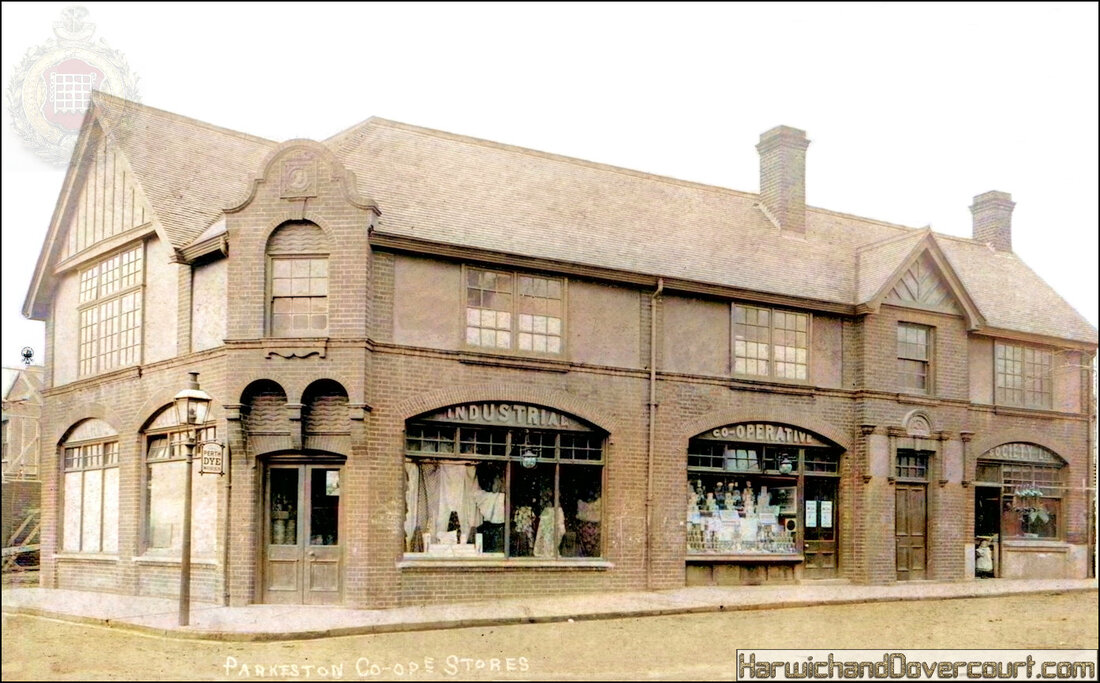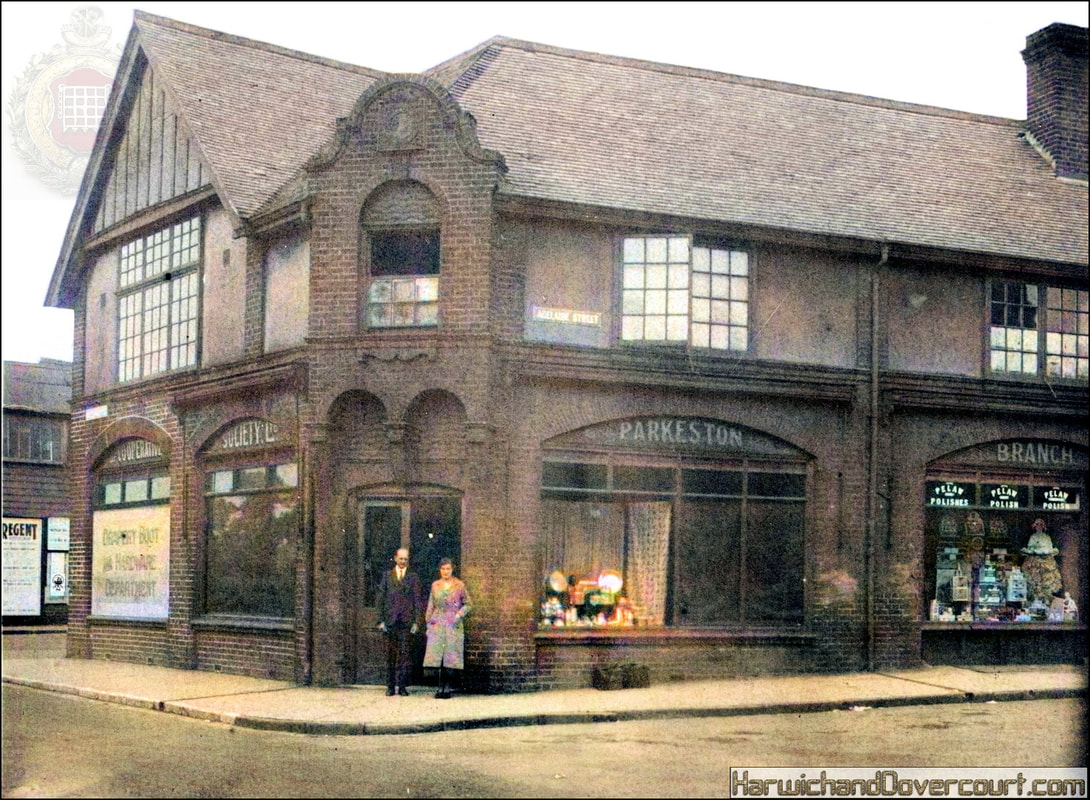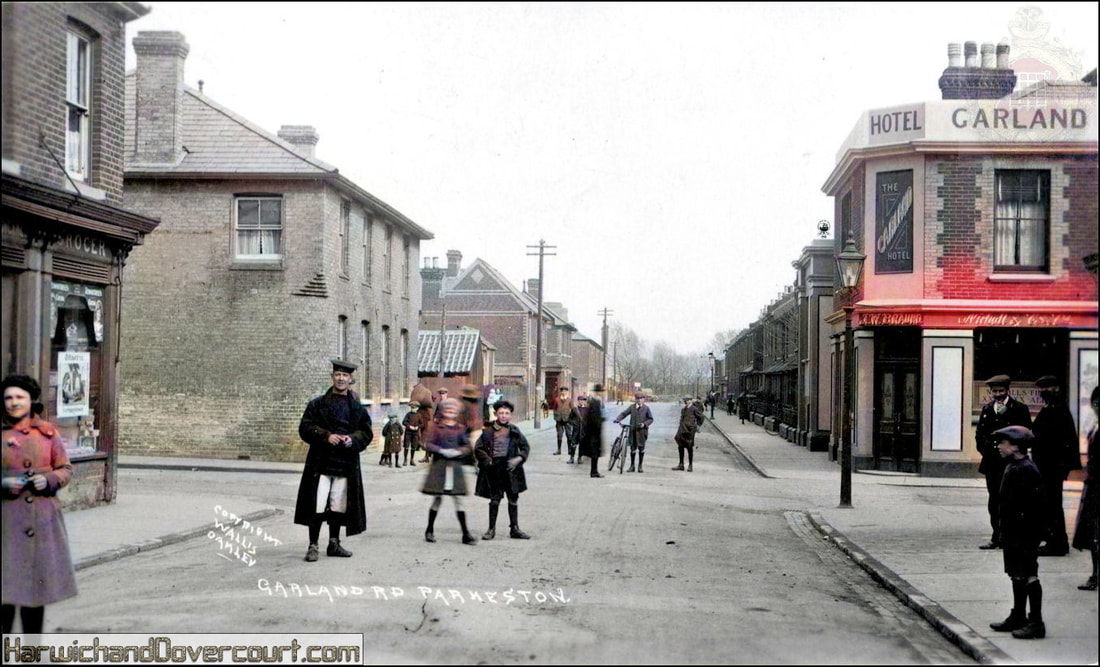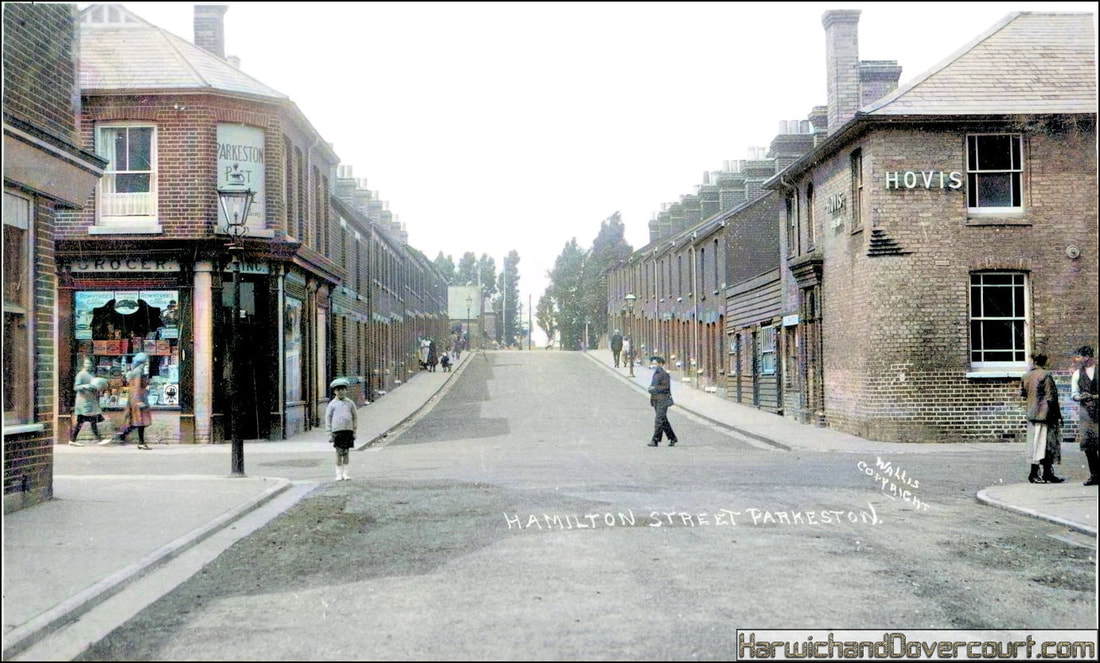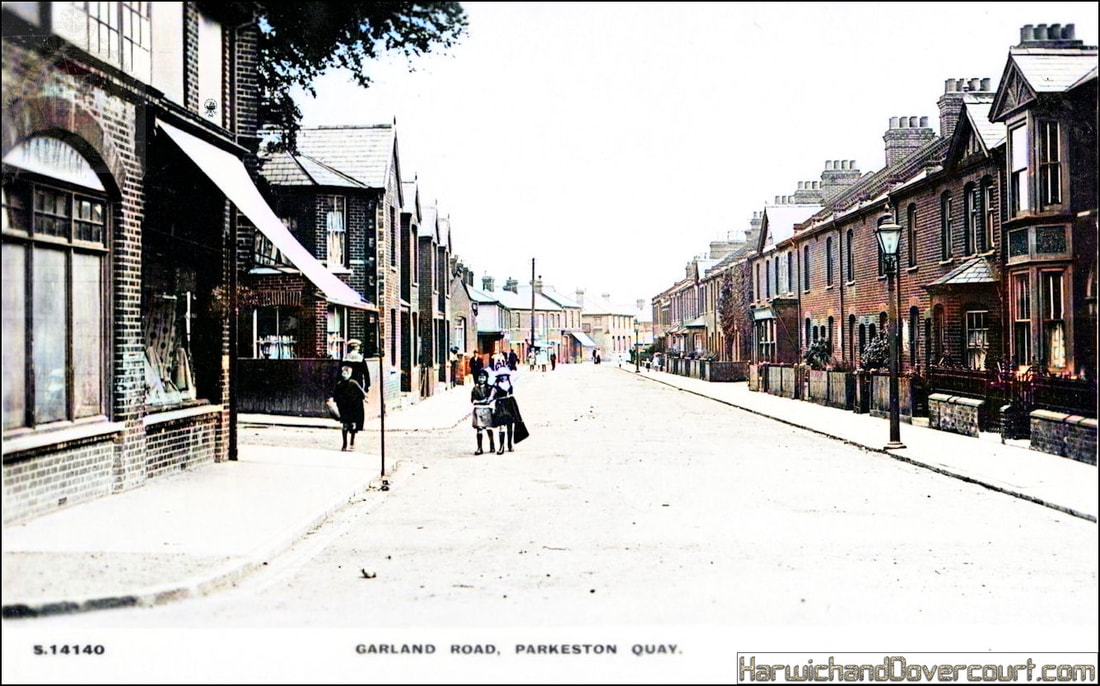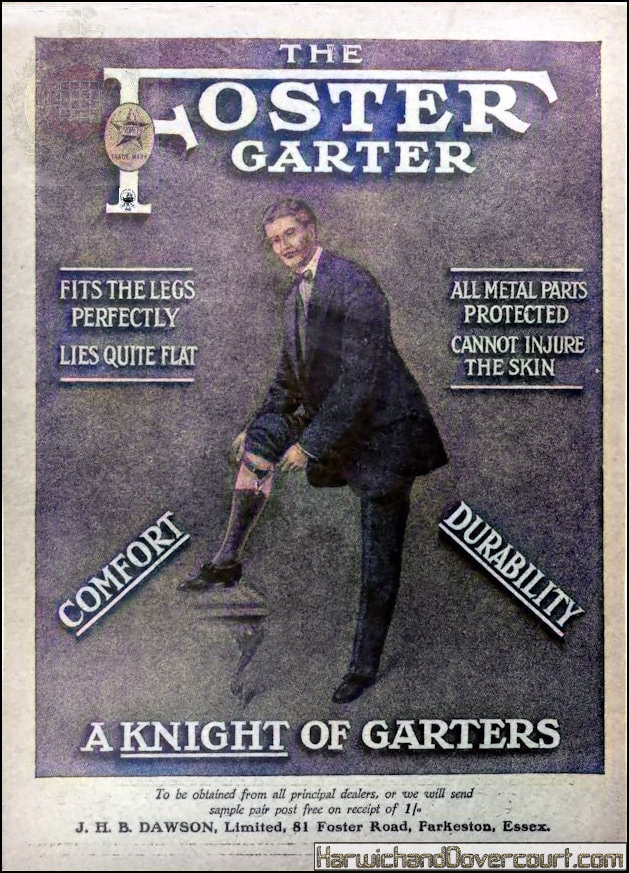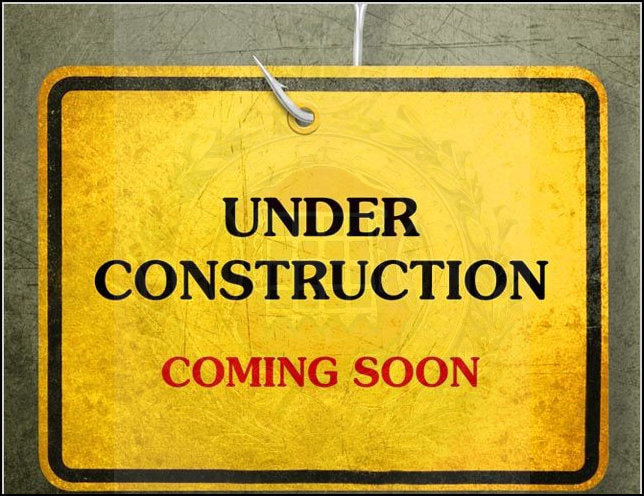Parkeston Retailers & Factories
01 Parkeston Co-op Stores (1907) H&D FW
Harwich and Dovercourt Co-operative Society
In 1897 the Co-op opened a branch comprising butchers, a grocery and a drapery. Arguably the most significant contribution the Co-op made to village life was the provision of a meeting room which doubled as a library for a while. Not that the Co-op was the only shop in Parkeston, far from it. Although the more senior villagers argue about exact numbers, even in the early years of the last century the number stood at least twenty two. There was a Post office, baker’s, fish mongers and butcher’s as well as a variety of grocer’s shops and general stores. If you add to this number all the street traders that visited the village one gets a picture of a thriving bustling, Self-sufficient community which, for the most part at least, was independent of the outside world.
The social life of the village was also well catered for. There were meeting halls at the Co-op, the Chapel and the Tin Tabernacle, and later the Railway Club and the Scout hut in Foster Road. There was a sports field on Hamilton Park for football, cricket, bowls and quoits, probably named after the Great Eastern Railway vessel P.S. “Adelaide” built in 1880. Again the street developed on both sides 1883-1885. In 1897 the south west corner of the street provided the site for the local branch of the Co-operative Wholesale Society.
In 1897 the Co-op opened a branch comprising butchers, a grocery and a drapery. Arguably the most significant contribution the Co-op made to village life was the provision of a meeting room which doubled as a library for a while. Not that the Co-op was the only shop in Parkeston, far from it. Although the more senior villagers argue about exact numbers, even in the early years of the last century the number stood at least twenty two. There was a Post office, baker’s, fish mongers and butcher’s as well as a variety of grocer’s shops and general stores. If you add to this number all the street traders that visited the village one gets a picture of a thriving bustling, Self-sufficient community which, for the most part at least, was independent of the outside world.
The social life of the village was also well catered for. There were meeting halls at the Co-op, the Chapel and the Tin Tabernacle, and later the Railway Club and the Scout hut in Foster Road. There was a sports field on Hamilton Park for football, cricket, bowls and quoits, probably named after the Great Eastern Railway vessel P.S. “Adelaide” built in 1880. Again the street developed on both sides 1883-1885. In 1897 the south west corner of the street provided the site for the local branch of the Co-operative Wholesale Society.
02 Parkeston Co-op Stores (1927) H&D FW
Harwich and Dovercourt Co-operative Society, Parkeston (1927)
Little had changed in 20 years in the south west corner of Adelaide Street, Parkeston, which stood the local branch of the Co-operative Wholesale Society. The premises comprised of a butchers, a grocery and a drapery. Just to the right of the store, is a poster announcing the opening of the "Regent Cinema" in Dovercourt.
Strangely this post card was never issued, but was used as a "proof" from the cutting room and is twice the size of the standard card.
Little had changed in 20 years in the south west corner of Adelaide Street, Parkeston, which stood the local branch of the Co-operative Wholesale Society. The premises comprised of a butchers, a grocery and a drapery. Just to the right of the store, is a poster announcing the opening of the "Regent Cinema" in Dovercourt.
Strangely this post card was never issued, but was used as a "proof" from the cutting room and is twice the size of the standard card.
03 124006 Adelaide Street, Parkeston (1929) by Bells H&D FW
04 Garland Rd, Parkeston (1923) Copyright Wallis. Oakley H&D FW
05 Hamilton Street, Parkeston (1923) Wallis H&D FW
Parkeston Post Office & Grocery Store "C.H.King" in Hamilton Street, Parkeston by "Wallis" around 1923.
The road was built in the 1880’s, with housing in the southern end and a School, Church and Village Hall in the upper Northern end (note the gates at the top of the road, marking the dividing line have now been removed).
It's nice to see the Chivers Jellies and Rowntree's Cocoa in the shop window.
Lord Claude Hamilton (1843-1925), a former chairman of G.E.R., also gave his name [Hamilton Park] to the extensive playing fields between the village and the station/quay area.
Google Link & Postcode: CO12 4PQ
The road was built in the 1880’s, with housing in the southern end and a School, Church and Village Hall in the upper Northern end (note the gates at the top of the road, marking the dividing line have now been removed).
It's nice to see the Chivers Jellies and Rowntree's Cocoa in the shop window.
Lord Claude Hamilton (1843-1925), a former chairman of G.E.R., also gave his name [Hamilton Park] to the extensive playing fields between the village and the station/quay area.
Google Link & Postcode: CO12 4PQ
06 S.14140 Garland Road, Parkeston Quay (1912) Kingsway H&D FW
07 Corset Factory, Foster Road, Parkeston F CO12 4QG H&D FW
The “Engine Drivers” Hostel (Hamilton House), Foster Road, Parkeston (1911)
This versatile building named after the Chairman of the Great Eastern Railway (Claud Hamilton 1843–1925) is situated at the eastern end of Foster Road, Parkeston. The building started life at the turn of the century, as an engine drivers hostel (as shown here). However a few years later, but prior to the outbreak of WW1, it was used as a factory by “The Foster Manufacturing Company“, producing corsets, suspenders and under-garments etc.
During WW1 the factory switched production to military supplies and clothing, but after the end of the war, it reverted back to clothing. Between 1933-1939 and again in 1945-1982, it at acted as "The Customs House", while the onset of WW2 in 1940 - 1945 it was again utilised by the military (Admiralty) as an emergency port control centre with underground bunkers and an operations room.
This Royal Naval Auxiliary Service (RNXS), was still utilised up to 1992, all though the “Cold War” period.
More recently Hamilton House has been utilised as an occupational health centre.
This versatile building named after the Chairman of the Great Eastern Railway (Claud Hamilton 1843–1925) is situated at the eastern end of Foster Road, Parkeston. The building started life at the turn of the century, as an engine drivers hostel (as shown here). However a few years later, but prior to the outbreak of WW1, it was used as a factory by “The Foster Manufacturing Company“, producing corsets, suspenders and under-garments etc.
During WW1 the factory switched production to military supplies and clothing, but after the end of the war, it reverted back to clothing. Between 1933-1939 and again in 1945-1982, it at acted as "The Customs House", while the onset of WW2 in 1940 - 1945 it was again utilised by the military (Admiralty) as an emergency port control centre with underground bunkers and an operations room.
This Royal Naval Auxiliary Service (RNXS), was still utilised up to 1992, all though the “Cold War” period.
More recently Hamilton House has been utilised as an occupational health centre.
